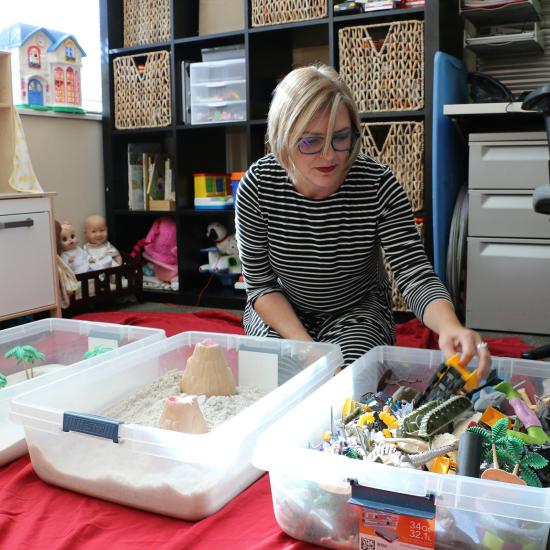Is Play Therapy Right for your Child?
Johnny just started first grade this fall. Kindergarten went well, but so far this year, Johnny’s parents have received five calls home about Johnny being aggressive with other children, not following adult directions and not sitting still. When asked what is upsetting him, Johnny says “I don’t know” or “I was mad.”
After struggling to help their son’s behavior, Johnny’s parents make the difficult decision to pursue therapy for him. Then comes another challenge: What kind of therapy? The number of options can feel overwhelming. In this blog post, I hope to make that decision easier by using Johnny as an example to provide information about experiential play therapy, a type of therapy that I practice in the Wilder Foundation's Community Mental Health and Wellness Services.
In Johnny’s example, his parents meet with a therapist who asks for details about what Johnny is struggling with, his family history and if anything has changed recently. The therapist learns that the family recently moved to a new house, and in July Johnny broke his arm in a serious car accident.
Types of Play Therapy
Johnny’s therapist recommends play therapy, a type of therapy that can be helpful because play is the way children learn and the easiest way to express themselves. Some practitioners use directive play therapy, in which the therapist leads and play is used as a tool. Others use child-directed play therapy, in which the child leads the play.
Johnny’s therapist uses experiential play therapy, a type of child-directed therapy that can be helpful for kids who struggle with anxiety, depression, traumatic experiences, physical and emotional regulation, relationship issues and adjusting to changes in their lives. It can be used with children as young as 18 months old to 13 years old. If children play pretend, they can do experiential play therapy.
The belief behind experiential play therapy is that children will naturally seek to heal and will progress at a pace that is comfortable to them. Another belief is that there is metaphorical meaning in children's play. The therapist's role is to support Johnny in processing his struggles by following the need and meaning within his play. The therapist tracks his progress and interacts in his play to level he is at, and gives him an environment that is safe for him to face his struggles.
Breaking Sandcastles, Building Self-Esteem
Johnny’s therapy may start with him building sand castles and then knocking them down. The therapist may respond with "Oh, it crashed," or mirroring how it would feel to crash or break emotionally. As Johnny feels more comfortable approaching the topic of moving, the accident and his injury, his play will look more closely like what actually happened.
Before that happens, Johnny needs to build up his self-esteem and sense of safety. In therapy, Johnny may show the therapist how fast he can run or he may have sword fights and amaze the therapist with how well he can protect himself. He does this because he could not run away from the accident and he could not be protected from the accident like he needed to. He may process the move by re-arranging the furniture in a play house in a way that he likes, or pretend playing that the kids decided not to move so the family did not. Again, he does this to gain a sense of control over a situation he did not have much control over.
Later in the therapy, Johnny gets out the cars, crashes them and an ambulance comes to help. He looks at the therapist and says, “This is what happened to me.” That is when the therapist knows he is able to think and talk about what happened.
Over the course of the therapy, Johnny’s teacher notices that he is able to focus more, he is fighting less and he does not disagree with teacher directions. His caregivers notice that he is sleeping better and he talks more positively about himself. For Johnny, therapy feels good, he wants to go and he feels better about himself.
Making a Choice
Is play therapy right for your child? In the end, you know your child best. It’s important that you and your child are comfortable with the type of therapy that you choose because it will help both of you have a better experience.
Christine Hensgens is a Clinical Social Worker (LICSW) at Wilder. In 2009, she was trained in Experiential Play Therapy by the creators of this therapy, Byron and Carol Norton. She continues to consult with the Nortons and works to train other professionals in the theory. She has been credentialed as a Registered Play Therapy Supervisor (RPT-S) by the National Association for Play Therapy (APT), and has been credentialed as an Infant Mental Health Clinician (IMH-III) by the Minnesota Association for Infant and Early Childhood Mental Health.
